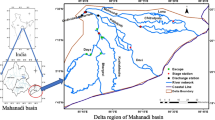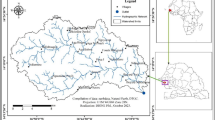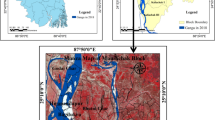Abstract
It is currently unclear how river restoration based on hydro-geometrical modifications, dredging, and creating a barrier instead of its removal on a river would affect the water quality in urban rivers. This work attempts to fill this gap in our understanding by simulating the water quality of a highly critical 22-km-long Delhi stretch of river Yamuna in terms of DO, BOD, and total coliform after the implementation of these river restoration measures. Four scenarios were conceptualized based on these restoration measures and water quality simulated. These are: scenario I: simulate the impact of varying the width uniformly for all reaches of the study stretch on the water quality, scenario II: simulate the impact of increased depth by controlled dredging. Scenario III (a) closing the ITO barrage gate and then simulating river water quality from Wazirabad barrage to ITO barrage and (b) closing the ITO barrage and simulation of water quality from ITO barrage to Okhla barrage. Results reveal that the water quality improved significantly in scenario I and scenario II. Scenario III did not yield desirable results in terms of water quality improvement. To the best of the author’s knowledge, this is the first attempt involving river morphometry changes using the QUAL2k model for the Delhi stretch of river Yamuna.

Source: Delhi Jal Board (2016)












Similar content being viewed by others
Availability of data and materials
The datasets used and/or analyzed during the current study are available from the corresponding author on reasonable request.
References
Amin, D. O., & Banahene, P. (2021). Urbanization and stream ecosystems: The role of flow hydraulics towards an improved understanding in addressing urban stream degradation. Environmental Reviews. https://doi.org/10.1139/er-2020-0063
Anim, D. O., Fletcher, T. D., Vietz, G. J., Burns, M. J., & Pasternack, G. B. (2019). How alternative urban stream channel designs influence eco-hydraulic conditions. Journal of Environmental Management, 247, 242–252.
Bednarek, A. T. (2001). Undamming rivers: A review of the ecological impacts of dam removal. Environmental Management, 27, 803–814. https://doi.org/10.1007/s002670010189
Bednarska, A. J., Wyzga, B., Mikus, P., & Kedzior, R. (2018). Ground beetle communities in a mountain river subjected to restoration: The Raba River, Polish Carpathians. Science of the Total Environment, 610–611, 1180–1192.
Bernhardt, E. S., Palmer, M. A., Allan, J. D., Alexander, G., Barnas, K., Brooks, S., Carr, J., Clayton, S., Dahm, C., Follstad-shah, J., Galat, D., Gloss, S., Goodwin, P., Hart, D., Hassett, B., Jenkinson, R., Katz, S., Kondolf, G.M., Lake, P. S., Lave, R., Meyer, J. L., O'donnell, T. K., Pagano, L., Powell, B. & Sudduth, E. (2005). Forum on “Synthesizing U.S. River Restoration Efforts.”. Science, 308(5722), 636–637. https://doi.org/10.1126/science.110976
Bernhardt, E. S., & Palmer, M. A. (2007). Restoring streams in an urbanizing world. Freshwater Biology, 52(4), 738–751.
Bernhardt, E. S., & Palmer, M. A. (2011). River restoration: The fuzzy logic of repairing reaches to reverse catchment scale degradation. Ecological Applications, 21(6), 1926–1931. https://doi.org/10.1890/10-1574.1
Birnie-Gauvin, K., et al. (2018). Moving beyond fitting fish into equations: Progressing the fish passage debate in the Anthropocene. Aquatic Conservation: Marine and Freshwater Ecosystems, 29, 1095–1105.
Chapra, S. C., Pelletier, G. J., & Tao, H. (2008). QUAL2K: A modeling framework for simulating river and stream water quality, version 2.11: Documentation and user’s manual. Medford: Civil and Environmental Engineering Department, Tufts University.
Chaudhary, S., Dhanya, C. T., & Kumar, A. (2018). Sequential calibration of a water quality model using reach-specific parameter estimates. Hydrology Research, 49(4), 1042–1055.
CPCB. (2006–07). Water quality status of River Yamuna (1999–2005), assessment and development study of river basin series (ADSORBS). ADSORBS/41. Delhi: Central Pollution Control Board.
CPCB. (2011). Water quality status of Yamuna River. Assessment and development study of river basin series (ADSORBS) ADSORBS/32. New Delhi: Central Pollution Control Board.
Ding, L., Chen, L., & Ding, C. (2019). Global trends in dam removal and related research: A systematic review based on associated datasets and bibliometric analysis. Chinese Geographical Science, 29, 1–12.
Ding, L., Liqiang, C., Ding, C., & Tao, J. (2018). Global trends in dam removal and related research: A systematic review based on associated datasets and bibliometric analysis. Chinese Geographical Science. https://doi.org/10.1007/s11769-018-1009-8
DPCC. (2020). Report on water quality of Delhi stretch of river Yamuna-2019–2020. Delhi: Delhi Pollution Control Committee.
Duda, J. J., & Bellmore, J. R. (2022). Dam removal and river restoration. In T. Mehner & K. Tockner (Eds.), Encyclopedia of inland waters (2nd ed., pp. 576–585). Amsterdam: Elsevier. https://doi.org/10.1016/B978-0-12-819166-8.00101-8 ISBN 9780128220412.
Kannel, P. R., Lee, S., Lee, Y. S., Kanel, S. R., & Khan, S. P. (2007). Application of water quality indices and dissolved oxygen as indicators for river water classification and urban impact assessment. Environmental Monitoring and Assessment, 132, 93–110. https://doi.org/10.1007/s10661-006-9505-1
Kazmi, A. A., & Hansen, I. S. (1997). Numerical models in water quality management: a case study for the Yamuna River (India). Water Science and Technology, 36(5), 193–200.
Keshari, A. K., & Parmar, D. (2006). Discussion on “Pollution management in the twentieth century.” Journal of Environmental Engineering, 132(11), 1543–1546. https://doi.org/10.1061/(ASCE)0733-9372(2006)132:11(1543)
Paliwal, R., Sharma, P., & Kansal, A. (2007). Water quality modelling of the river Yamuna (India) using QUAL2E-UNCAS. Journal of Environmental Management, 83(2), 131–144.
Palmer, M. A., Filoso, S., & Fanelli, R. M. (2014). From ecosystems to ecosystem services: Stream restoration as ecological engineering. Ecological Engineering, 65, 62–70.
Parmar, D., & Keshari, A. K. (2012). Sensitivity analysis of water quality for Delhi stretch of the River Yamuna, India. Environmental Monitoring and Assessment, 184(3), 1487–1508. https://doi.org/10.1007/s10661-011-2055-1
Parmar, D., & Keshari, A. K. (2014). Wasteload allocation using wastewater treatment and flow augmentation. Environmental Modeling and Assessment, 19(1), 35–44. https://doi.org/10.1007/s10666-013-9378-y
Parmar, D., & Keshari, A. K. (2018). Simulating strategic measures for managing water quality in the Delhi stretch of the River Yamuna, India. Sustainable Water Resources Management, 4(4), 1123–1133. https://doi.org/10.1007/s40899-018-0289-6
Parmar, D., & Keshari, A. K. (2020a). Discussion of water quality-based environmental flow under plausible temperature and pollution scenarios. By Shushobhit Chaudhary, C. T. Dhanya, Arun Kumar, and Rehana Shaik. Journal of Hydrologic Engineering, ASCE. https://doi.org/10.1061/(ASCE)HE.1943-5584.0001780
Parmar, D., & Keshari, A. K. (2020b). Monitoring and processing of data for effective wasteload allocation modeling in India. In T. Gupta, S. Singh, P. Rajput, & A. Agarwal (Eds.), Measurement, analysis and remediation of environmental pollutants. Energy, environment, and sustainability (pp. 357–373). Singapore: Springer. https://doi.org/10.1007/978-981-15-0540-9_17
Parmar, D., & Keshari, A. K. (forthcoming). Multi-objective wasteload allocation: Application to Delhi stretch of the river Yamuna, India. International Journal of Environmental and Waste Management. https://doi.org/10.1504/IJEWM.2023.10045111 (in press).
Rehana, S., & Mujumdar, P. P. (2011). River water quality response under hypothetical climate change scenarios in Tunga-Bhadra River, India. Hydrological Processes, 25(22), 3373–3386. https://doi.org/10.1002/hyp.8057
Sharma, D., Gupta, R., Kansal, A., & Singh, R. K. (2011). Characteristics of the event mean concentration (EMCs) from rainfall runoff on mixed agricultural land use in the shoreline zone of the Yamuna River in Delhi India. Applied Water Science. https://doi.org/10.1007/s13201-011-0022-1
Sharma, D., Kansal, A., & Pelletier, G. (2017). Water quality modeling for urban reach of Yamuna river, India (1999–2009), using QUAL2Kw. Applied Water Science, 7, 1535–1559. https://doi.org/10.1007/s13201-015-0311-1
Sharma, D., & Singh, R. K. (2009). DO-BOD modeling of River Yamuna for national capital territory India using stream II a 2D water quality model. Environmental Monitoring Assessment, 159(1–4), 231–240.
Singh, A. P., Ghosh, S. K., & Sharma, P. (2007). Water quality management of a stretch of river Yamuna: An interactive fuzzy multi-objective approach. Water Resources Management, 21(2), 515–553.
Sippi, S., & Parmar, D. (2022). Water quality based ranking and benchmarking of rivers in India using multicriteria decision making technique. Journal of Hazardous, Toxic and Radioactive Waste, ASCE. https://doi.org/10.1061/(ASCE)HZ.2153-5515.0000669
Thomann, R. V. (1972). Systems analysis and water quality management. McGraw-Hill.
Turner, M., & Stewardson, M. (2014). Hydrologic indicators of hydraulic conditions that drive flow–biota relationships. Hydrological Sciences Journal, 59(3–4), 659–672. https://doi.org/10.1080/02626667.2014.896997
Vietz, G. J., Rutherfurd, I. D., Fletcher, T. D., & Walsh, C. J. (2016). Thinking outside the channel: Challenges and opportunities for protection and restoration of stream morphology in urbanizing catchments. Landscape and Urban Planning, 145, 34–44.
Walling, B., Chaudhary, S., Dhanya, C. T., & Kumar, A. (2019). Estimation of environmental flow incorporating water quality and hypothetical climate change scenarios. Environmental Monitoring and Assessment, 189(5), 225. https://doi.org/10.1007/s10661-017-5942-2
Wei, G., Yang, Z., & Cui, B. (2009). Impact of dam construction on water quality and water self-purification capacity of the Lancang River, China. Water Resources Management, 23, 1763–1780. https://doi.org/10.1007/s11269-008-9351-8
Wheaton, J. M., Brasington, J., Darby, S. E., Merz, J., Pasternack, G. B., Sear, D., & Vericat, D. (2010). Linking geomorphic changes to salmonid habitat at a scale relevant to fish. River Research Applications, 26, 469–486.
Wohl, E., Angermeier, P., Bledsoe, B., Kondolf, G. M., MacDonnell, L., Merritt, D., Palmer, M., Poff, N., & Tarboton, D. (2005). River restoration. Water Resources Research. https://doi.org/10.1029/2005WR003985
Wohl, E., Lane, S. N., & Wilcox, A. C. (2015). The science and practice of river restoration. Water Resources Research, 51(8), 5974–5997.
Yadav, D. V., Parmar, D., Ganguly, R., & Shukla, S. (2022). Efficiency evaluation of sewage treatment plants in Delhi, India, using tolerance-based data envelope analysis. Environmental Monitoring and Assessment, 194, 867. https://doi.org/10.1007/s10661-022-10528-4
Zainudin, Z., Rahman, N. A., Abdullah, N., & Mazlan, N. F. (2010). Development of water quality model for Sungai Tebrau using QUAL2K. Journal of Applied Sciences, 10, 2748–2750.
Zhang, R., Qian, X., Yuan, X., Ye, R., **a, B., & Wang, Y. (2012). Simulation of water environmental capacity and pollution load reduction using QUAL2K for water environmental management. International Journal of Environmental Research and Public Health, 9, 4504–4521.
Acknowledgements
This study was carried out as a doctoral thesis of the first author under the second author. The TEQIP-II fellowship received by the first author from HBTU Kanpur is acknowledged.
Funding
The authors declare that no funds, grants, or other support were received during the preparation of this manuscript.
Author information
Authors and Affiliations
Contributions
All authors contributed to this study as per the details below: First author was involved in data collection, processing, analysis, and the first draft of the manuscript. Second author helped in conceptualization of the research problem, supervision, revision of the manuscript—especially the introduction, results and discussion, conclusions. All authors read and approved the final manuscript.”
Corresponding author
Ethics declarations
Competing interests
The authors declare that they have no known competing financial interests or personal relationships that could have appeared to influence the work reported in this paper. The authors declare that they do not have any potential conflicts of interest.
Consent to participate
Not applicable.
Consent to publish
The authors hereby give their consent for the submission of this manuscript to this journal. All authors read and approved the final manuscript.
Additional information
Publisher's Note
Springer Nature remains neutral with regard to jurisdictional claims in published maps and institutional affiliations.
Rights and permissions
Springer Nature or its licensor (e.g. a society or other partner) holds exclusive rights to this article under a publishing agreement with the author(s) or other rightsholder(s); author self-archiving of the accepted manuscript version of this article is solely governed by the terms of such publishing agreement and applicable law.
About this article
Cite this article
Sippi, S., Parmar, D. Water quality simulation under river restoration measures for the Delhi stretch of river Yamuna, India. Environ Dev Sustain 26, 5891–5914 (2024). https://doi.org/10.1007/s10668-023-02943-5
Received:
Accepted:
Published:
Issue Date:
DOI: https://doi.org/10.1007/s10668-023-02943-5




